ACTA AERONAUTICAET ASTRONAUTICA SINICA ›› 2023, Vol. 44 ›› Issue (2): 626310-626310.doi: 10.7527/S1000-6893.2021.26310
Previous Articles Next Articles
Yulin DING1,2, Zhonghua HAN1,2( ), Jianling QIAO1,2, Han NIE1,2, Wenping SONG1,2, Bifeng SONG1,2
), Jianling QIAO1,2, Han NIE1,2, Wenping SONG1,2, Bifeng SONG1,2
Received:2021-09-02
Revised:2021-09-24
Accepted:2021-10-12
Online:2023-01-25
Published:2021-10-14
Contact:
Zhonghua HAN
E-mail:hanzh@nwpu.edu.cn
Supported by:CLC Number:
Yulin DING, Zhonghua HAN, Jianling QIAO, Han NIE, Wenping SONG, Bifeng SONG. Research progress in key technologies for conceptual-aerodynamic configuration design of supersonic transport aircraft[J]. ACTA AERONAUTICAET ASTRONAUTICA SINICA, 2023, 44(2): 626310-626310.
Table 1
History and technical features of three generations of supersonic transport aircraft configurations
| 划代 | 典型技术特点 | 代表性布局 | |
|---|---|---|---|
| 第1代 |  |  | 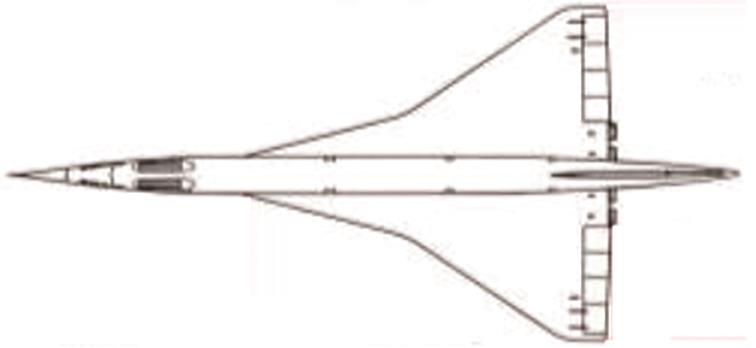 |
| Concorde | Tupolev Tu-144 | ||
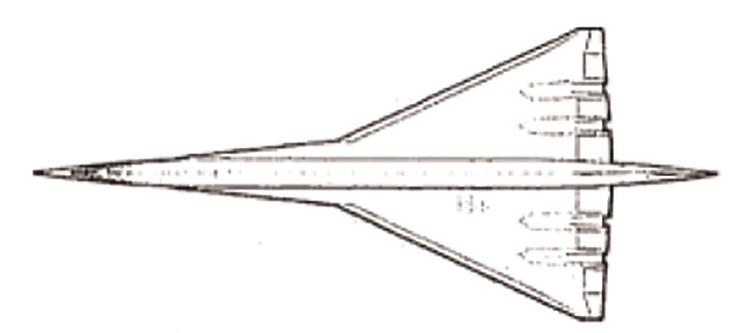 |  | ||
| Lockheed L-2000 | Boeing B-2707 | ||
| 第2代 | 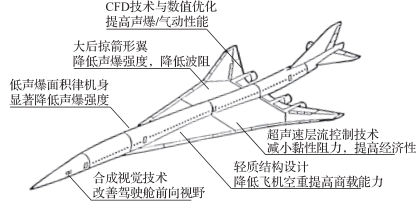 |  | 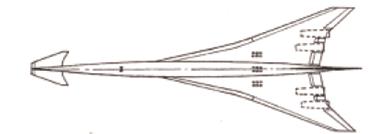 |
| Boeing HSCT | Douglas HSCT | ||
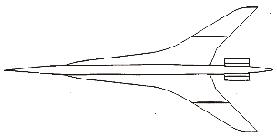 |  | ||
| NASA Langley HSCT | NASA AME HSCT | ||
| 第3代 | 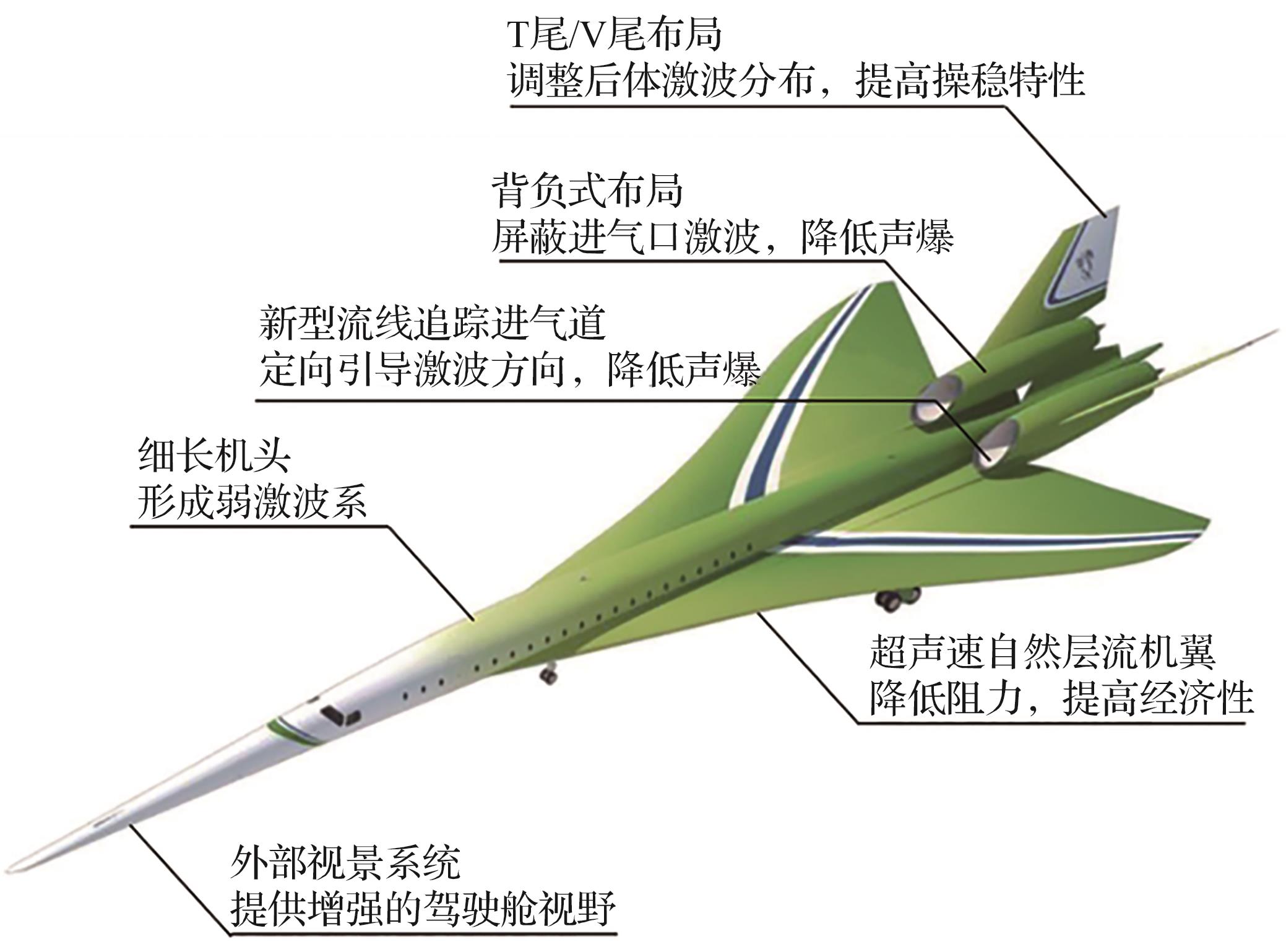 | 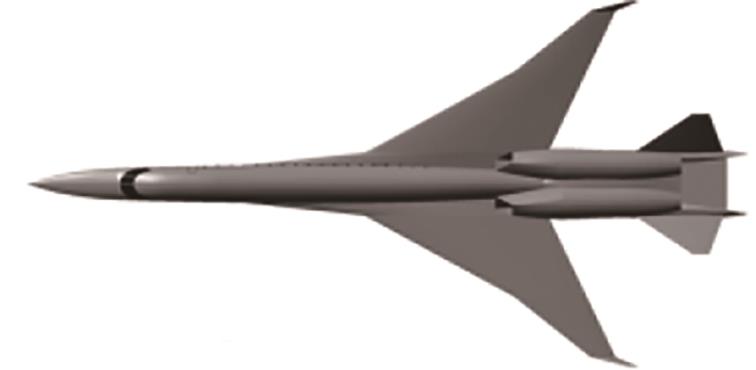 |  |
| JAXA SSBJ | JAXA S4 | ||
 |  | ||
| Boeing N+2 QEVC2 | Lockheed N+2 LM-1044 | ||
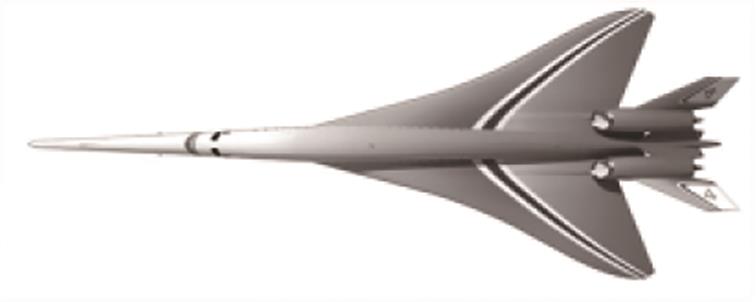 |  | ||
| Lockheed QSTA | NASA X-59 QueSST | ||
| 1 | AIRBUS. Growing horizons 2017-2036[R]. Toulouse: Airbus S. A.S., 2017. |
| 2 | TINSETH R. Current market outlook 2017-2036[R]. Chicago: Boeing Commercial Airplanes, 2017. |
| 3 | NASA Aeronautics Research Mission Directorate. NASA aeronautics: Strategic implementation plan-2019 update: NASA NP-2017-01-2352-HQ[R]. Washington, D.C.: NASA, 2019. |
| 4 | 王刚, 张彬乾, 张明辉, 等. 翼身融合民机总体气动技术研究进展与展望[J]. 航空学报, 2019, 40(9): 623046. |
| WANG G, ZHANG B Q, ZHANG M H, et al. Research progress and prospect for conceptual and aerodynamic technology of blended-wing-body civil aircraft[J]. Acta Aeronautica et Astronautica Sinica, 2019, 40(9): 623046 (in Chinese). | |
| 5 | 韩忠华, 钱战森, 乔建领. 声爆预测与低声爆设计[M].北京: 科学出版社, 2022: 189-192. |
| HAN Z H, QIAN Z S, QIAO J L. Sonic-boom prediction and low-boom design method [M]. Beijing: Science Press, 2022: 189-192 (in Chinese). | |
| 6 | 冯晓强. 超声速客机低声爆机理及设计方法研究[D]. 西安: 西北工业大学, 2014: 3-4. |
| FENG X Q. Study on mechanism and design method of supersonic passenger plane’s low sound explosion[D]. Xi’an: Northwestern Polytechnical University, 2014: 3-4 (in Chinese). | |
| 7 | CHUDOBA B, COLEMAN G, ROBERTS K, et al. What price supersonic speed? -A design anatomy of supersonic transportation-part 1[C]∥45th AIAA Aerospace Sciences Meeting and Exhibit. Reston: AIAA, 2007. |
| 8 | CANDEL S. Concorde and the future of supersonic transport[J]. Journal of Propulsion and Power, 2004, 20(1): 59-68. |
| 9 | PEIREN G. Tu-144 supersonic transport[J]. Civil Aircraft Design and Resarch, 2015(3): 99-102. |
| 10 | BISPLINGHOFF R L. The supersonic transport[J]. Scientific American, 1964, 210(6): 25-35. |
| 11 | RAY E J. NASA supersonic commercial air transport (SCAT) configurations: A summary and index of experimental characteristics: NASA TM X-1329 [R]. Washington, D.C.: NASA, 1967. |
| 12 | CONWAY E M. High-speed dreams: NASA and the technopolitics of supersonic transportation, 1945–1999[M]. Baltimore: Johns Hopkins University Press, 2005: 866-867. |
| 13 | KRESSNER W K H. The 2707 supersonic transport[J]. Proceedings of the IEEE, 1968, 56(4): 682-691. |
| 14 | HEPPE R R, ENGLEBRY C R. An account of the design philosophy of the Lockheed SST project[J]. Aircraft Engineering and Aerospace Technology, 1967, 39(1): 25-38. |
| 15 | ROWE W T. Technology status for an advanced supersonic transport[C]∥SAE Technical Paper Series. NewYork: SAE International, 1982. |
| 16 | MAGLIERI D J, BOBBITT P J, PLOTKIN K J, et al. Sonic boom six decades of research: NASA SP-622 [R]. Washington, D.C.: NASA, 2014. |
| 17 | BAIZE D G. The 1995 NASA high-speed research program sonic boom workshop: NASA-CP-3335-Vol-1 [R]. Washington, D.C.: NASA, 1996. |
| 18 | BOEING COMMERCIAL AIRPLANES. High-speed civil transport study: NASA-CR-4233[R]. Washington, D.C.: NASA, 1989. |
| 19 | DOUGLAS AIRCRAFT COMPANY. Study of high-speed civil transports: NASA CR-1989-4235[R]. Washington, D.C.: NASA, 1989. |
| 20 | BOEING COMMERCIAL AIRPLANES. High-speed civil transport study. Summary: NASA-CR-4234[R]. Washington, D.C.: NASA, 1989. |
| 21 | GREEN P K, PACULL M, REIMERS H D. European 2nd generation supersonic commercial transport aircraft[C]∥Proceedings of the 20th International Congress of the Aeronautical Sciences. Sorrento: ICAS, 1996. |
| 22 | YAMAKAMI K, NAKAHASHI K, OBAYASHI S. Aerodynamic design and CFD evaluation of a high speed commercial transport: NAL SP-34 [R]. Tokyo: National Aerospace Laboratory, 1997. |
| 23 | SCOTT G A, MICHAEL C F. F-16XL-2 supersonic laminar flight test experiment: NASA/TP-1999-209683[R]. Washington, D.C.: NASA, 1999. |
| 24 | WOOD R M. First NASA/industry high-speed research configuration aerodynamics workshop:NASA/CP-1999-209690/PT3 [R]. Washington, D.C.: NASA, 1999. |
| 25 | ALAN W W, ROBERT J S. An overview of NASA’s high-speed research program[C]∥Proceedings of the 22nd International Congress of the Aeronautical Science,2000. |
| 26 | DAVID A M. High-speed research: 1994 sonic boom workshop: NASA/CP-1999-209699 [R]. Washington, D.C.: NASA, 1999. |
| 27 | SCHRAGE D, MAVRIS D. Integrated design and manufacturing for the high speed civil transport[C]∥Aircraft Design, Systems, and Operations Meeting. Reston: AIAA, 1993. |
| 28 | MORGENSTERN J, NORSTRUD N, STELMACK M, et al. Advanced concept studies for supersonic commercial transports entering service in 2030-35 (N+3)[C]∥28th AIAA Applied Aerodynamics Conference. Reston: AIAA, 2010. |
| 29 | LIEBHARDT B, LÜTJENS K, UENO A, et al. JAXA’s S4 supersonic low-boom airliner - A collaborative study on aircraft design, sonic boom simulation, and market prospects[C]∥AIAA Aviation 2020 Forum. Reston: AIAA, 2020. |
| 30 | MICHAEL B.Conceptual design of a quiet supersonic technology airliner[C]∥AIAA Aviation 2019 Forum. Reston: AIAA, 2019. |
| 31 | RICHWINE D, BRANDON J. Quiet supersonic technology (QueSST) aircraft preliminary design status and low-boom flight demonstration (LBFD) project update[C]∥48th AIAA Fluid Dynamics Conference. Reston: AIAA, 2018. |
| 32 | 朱自强, 兰世隆. 超声速民机和降低音爆研究[J]. 航空学报, 2015, 36(8): 2507-2528. |
| ZHU Z Q, LAN S L. Study of supersonic commercial transport and reduction of sonic boom[J]. Acta Aeronautica et Astronautica Sinica, 2015, 36(8): 2507-2528 (in Chinese). | |
| 33 | 钱战森, 韩忠华. 声爆研究的现状与挑战[J]. 空气动力学学报, 2019, 37(4): 601-619, 600. |
| QIAN Z S, HAN Z H. Progress and challenges of sonic boom research[J]. Acta Aerodynamica Sinica, 2019, 37(4): 601-619, 600 (in Chinese). | |
| 34 | 张力文, 宋文萍, 韩忠华, 等. 声爆产生、传播和抑制机理研究进展[J/OL]. 航空学报, (2021-08-04)[2021-09-29]. . |
| ZHANG L W, SONG W P, HAN Z H, et al. Recent progress of sonic boom generation, propagation and mitigation mechanism[J/OL]. Acta Aeronautica et Astronautica Sinica, (2021-08-04) [2021-09-29]. (in Chinese). | |
| 35 | TODD E M, STEPHEN G S, SPENCER R F. Experimental validations of a low-boom aircraft design[C]∥16th AIAA Aerospace Sciences Meeting including the New Horizous Forum and Aerospace Exposition. Reston: AIAA, 2013. |
| 36 | HARRY R W, CHET N, JIMMY T. N+2 supersonic concept development and systems integration: NASA/CR-2010-216842[R]. Washington, D.C.: NASA, 2010. |
| 37 | MORGENSTERN J, NORSTRUD N, SOKHEY J, et al. Advanced concept studies for supersonic commercial transports entering service in the 2018 to 2020 period Phase I Final Report: NASA/CR-2013-217820[R]. Washington, D.C.: NASA, 2013. |
| 38 | TODD E M, PETER A W, SPENCER R F, et al. System-level experimental validations for super-sonic commercial transport aircraft entering service in the 2018-2020 time period: NASA/CR–2013-217797[R]. Washington, D.C.: NASA, 2013. |
| 39 | HARRY W C, RAYMOND L B, ROBERT J M. Application of sonic-boom minimization concepts in supersonic transport design: NASA TN, D-7218[R]. Washington, D.C.: NASA, 1973. |
| 40 | BAIZE D G. 1995 NASA high-speed research program sonic boom workshop Volume II-Configuration design, analysis, and testing: NASA/CP-1999-209520/VOL2[R]. Washington, D.C.: NASA, 1999. |
| 41 | SUN Y C, SMITH H. Review and prospect of supersonic business jet design[J]. Progress in Aerospace Sciences, 2017, 90: 12-38. |
| 42 | DARDEN C M. Sonic-boom minimization with nose-bluntness relaxation: NASA TP-1348[R]. Washington, D.C.: NASA, 1979. |
| 43 | ARONSTEIN D C, SCHUELER K L. Two supersonic business aircraft conceptual designs with and without sonic boom constraint[J]. Journal of Aircraft, 2005, 42(3): 775-786. |
| 44 | BHATIA K, WERTHEIMER J. Aeroelastic challenges for a high speed civil transport[C]∥34th Structures, Structural Dynamics and Materials Conference. Reston: AIAA, 1993. |
| 45 | SILVA W A, DE LA GARZA A, ZINK P S, et al. An overview of the NASA high speed ASE project: Aeroelastic analyses of a low-boom supersonic configuration[C]∥56th AIAA/ASCE/AHS/ASC Structures, Structural Dynamics, and Materials Conference. Reston: AIAA, 2015. |
| 46 | PAK C G. Aeroelastic tailoring study of an N+2 low-boom supersonic commercial transport aircraft[C]∥16th AIAA/ISSMO Multidisciplinary Analysis and Optimization Conference. Reston: AIAA, 2015. |
| 47 | CONNOLLY J W, KOPASAKIS G, CHWALOWSKI P, et al. Aero-propulso-elastic analysis of a supersonic transport[J]. Journal of Aircraft, 2020, 57(4): 569-585. |
| 48 | SILVA W A, SANETRIK M D, CHWALOWSKI P. Computational aeroelastic analyses of a low-boom supersonic configuration[C]∥33rd AIAA Applied Aerodynamics Conference. Reston: AIAA, 2015. |
| 49 | NIKBAY M, STANFORD B, WEST T K, et al. Impact of aeroelastic uncertainties on sonic boom signature of a commercial supersonic transport configuration[C]∥55th AIAA Aerospace Sciences Meeting. Reston: AIAA, 2017. |
| 50 | PHILLIPS B D, WEST T K. Aeroelastic uncertainty quantification of a low-boom aircraft configuration[C]∥2018 AIAA Aerospace Sciences Meeting. Reston: AIAA, 2018. |
| 51 | RANDALL E B, SUSAN J W, JARVIS (TREY) J A III. Conceptual design standards for eXternal Visibility System (XVS) sensor and display resolution: NASA/TM-2012-217340[R]. Washington, D.C.: NASA, 2013. |
| 52 | BAILEY R E, WILLIAMS S, KIBLER K, et al. eXternal vision system development and testing for X-59 low boom flight demonstrator[C]∥AIAA Aviation 2020 Forum. Reston: AIAA, 2020. |
| 53 | JONES L B. Lower bounds for sonic Bangs[J]. The Journal of the Royal Aeronautical Society, 1961, 65(606): 433-436. |
| 54 | JONES L B. Lower bounds for sonic Bangs in the far field[J]. Aeronautical Quarterly, 1967, 18(1): 1-21. |
| 55 | JONES L B. Lower bounds for the pressure jump of the bow shock of a supersonic transport[J]. Aeronautical Quarterly, 1970, 21(1): 1-17. |
| 56 | SEEBASS R. Minimum sonic boom shock strengths and overpressures[J]. Nature, 1969, 221(5181): 651-653. |
| 57 | GEORGE A R, SEEBASS R. Sonic boom minimization including both front and rear shocks[J]. AIAA Journal, 1971, 9(10): 2091-2093. |
| 58 | SEEBASS R, GEORGE A R. Sonic‐boom minimization[J]. The Journal of the Acoustical Society of America, 1972, 51(2C): 686-694. |
| 59 | PLOTKIN K, RALLABHANDI S, LI W. Generalized formulation and extension of sonic boom minimization theory for front and aft shaping[C]∥47th AIAA Aerospace Sciences Meeting including the New Horizons Forum and Aerospace Exposition. Reston: AIAA, 2009. |
| 60 | HAAS A, KROO I. A multi-shock inverse design method for low-boom supersonic aircraft[C]∥48th AIAA Aerospace Sciences Meeting including the New Horizons Forum and Aerospace Exposition. Reston: AIAA, 2010. |
| 61 | MAKINO Y, SUZUKI K, NOGUCHI M, et al. Nonaxisymmetrical fuselage shape modification for drag reduction of low-sonic-boom airplane[J]. AIAA Journal, 2003, 41(8): 1413-1420. |
| 62 | JUNG T P, STARKEY R P, ARGROW B. Lobe balancing design method to create frozen sonic booms using aircraft components[J]. Journal of Aircraft, 2012, 49(6): 1878-1893. |
| 63 | HAGLUND G. HSCT designs for reduced sonic boom[C]∥Aircraft Design and Operations Meeting. Reston: AIAA, 1991. |
| 64 | GEORGE A R. Reduction of sonic boom by azimuthal redistribution of overpressure[J]. AIAA Journal, 1969, 7(2): 291-298. |
| 65 | 刘刚, 黄江涛, 周铸, 等. 超声速飞行器声爆/气动力综合设计技术研究[J]. 空气动力学学报, 2020, 38(5): 858-865. |
| LIU G, HUANG J T, ZHOU Z, et al. Investigation of supersonic low sonic boom aerodynamic configuration design[J]. Acta Aerodynamica Sinica, 2020, 38(5): 858-865 (in Chinese). | |
| 66 | LI W, SHIELDS E, GEISELHART K. Mixed-fidelity approach for design of low-boom supersonic aircraft[J]. Journal of Aircraft, 2011, 48(4): 1131-1135. |
| 67 | LI W, RALLABHANDI S. Inverse design of low-boom supersonic concepts using reversed equivalent-area targets[J]. Journal of Aircraft, 2014, 51(1): 29-36. |
| 68 | UENO A, KANAMORI M, MAKINO Y. Multi-fidelity low-boom design based on near-field pressure signature[C]∥54th AIAA Aerospace Sciences Meeting. Reston: AIAA, 2016. |
| 69 | LI W, SHIELDS E. Generation of parametric equivalent-area targets for design of low-boom supersonic concepts[C]∥49th AIAA Aerospace Sciences Meeting including the New Horizons Forum and Aerospace Exposition. Reston: AIAA, 2011. |
| 70 | 乔建领, 韩忠华, 丁玉临, 等. 基于广义Burgers方程的超声速客机远场声爆高精度预测方法[J]. 空气动力学学报, 2019, 37(4): 663-674. |
| QIAO J L, HAN Z H, DING Y L, et al. Sonic boom prediction method for supersonic transports based on augmented Burgers equation[J]. Acta Aerodynamica Sinica, 2019, 37(4): 663-674 (in Chinese). | |
| 71 | 王迪, 钱战森, 冷岩. 广义Burgers方程声爆传播模型高阶格式离散[J]. 航空学报, 2022, 43(1): 124916. |
| WANG D, QIAN Z S, LENG Y. High-order scheme discretization of sonic boom propagation model based on augmented Burgers equation[J]. Acta Aeronautica et Astronautica Sinica, 2022, 43(1): 124916 (in Chinese). | |
| 72 | ALONSO J, JAMESON A, KROO I. Advanced algorithms for design and optimization of quiet supersonic platforms[C]∥40th AIAA Aerospace Sciences Meeting & Exhibit. Reston: AIAA, 2002. |
| 73 | CHUNG H S, ALONSO J. Design of a low-boom supersonic business jet using cokriging approximation models[C]∥9th AIAA/ISSMO Symposium on Multidisciplinary Analysis and Optimization. Reston: AIAA, 2002. |
| 74 | CHAN M K. Supersonic aircraft optimization for minimizing drag and sonic boom[D]. Palo Alto: Stanford University, 2003. |
| 75 | CHOI S, ALONSO J, KROO I, et al. Multi-fidelity design optimization of low-boom supersonic business jets[C]∥10th AIAA/ISSMO Multidisciplinary Analysis and Optimization Conference. Reston: AIAA, 2004. |
| 76 | MAKINO Y, KROO I. Robust objective functions for sonic-boom minimization[J]. Journal of Aircraft, 2006, 43(5): 1301-1306. |
| 77 | FARHAT C, MAUTE K, ARGROW B, et al. Shape optimization methodology for reducing the sonic boom initial pressure rise[J]. AIAA Journal, 2007, 45(5): 1007-1018. |
| 78 | RALLABHANDI S K, MAVRIS D N. Aircraft geometry design and optimization for sonic boom reduction[J]. Journal of Aircraft, 2007, 44(1): 35-47. |
| 79 | RALLABHANDI S. Sonic boom adjoint methodology and its applications[C]∥29th AIAA Applied Aerodynamics Conference. Reston: AIAA, 2011. |
| 80 | RALLABHANDI S K. Application of adjoint methodology to supersonic aircraft design using reversed equivalent areas[J]. Journal of Aircraft, 2014, 51(6): 1873-1882. |
| 81 | ALONSO J J, COLONNO M R. Multidisciplinary optimization with applications to sonic-boom minimization[J]. Annual Review of Fluid Mechanics, 2012, 44: 505-526. |
| 82 | BAN N, YAMAZAKI W, KUSUNOSE K. Low-boom/low-drag design optimization of innovative supersonic transport configuration[J]. Journal of Aircraft, 2017, 55(3): 1071-1081. |
| 83 | KIRZ J. Surrogate based shape optimization of a low boom fuselage wing configuration[C]∥AIAA Aviation 2019 Forum. Reston: AIAA, 2019. |
| 84 | 冯晓强, 宋笔锋, 李占科, 等. 超声速飞机低声爆布局混合优化方法研究[J]. 航空学报, 2013, 34(8): 1768-1777. |
| FENG X Q, SONG B F, LI Z K, et al. Hybrid optimization approach research for low sonic boom supersonic aircraft configuration[J]. Acta Aeronautica et Astronautica Sinica, 2013, 34(8): 1768-1777 (in Chinese). | |
| 85 | 乔建领, 韩忠华, 宋文萍. 基于代理模型的高效全局低音爆优化设计方法[J]. 航空学报, 2018, 39(5): 121736. |
| QIAO J L, HAN Z H, SONG W P. An efficient surrogate-based global optimization for low sonic boom design[J]. Acta Aeronautica et Astronautica Sinica, 2018, 39(5): 121736 (in Chinese). | |
| 86 | ZHANG Y D, HUANG J T, GAO Z H, et al. Inverse design of low boom configurations using proper orthogonal decomposition and augmented Burgers equation[J]. Chinese Journal of Aeronautics, 2019, 32(6): 1380-1389. |
| 87 | 郝璇, 苏诚, 刘芳, 等. 超声速飞行器低声爆气动布局优化设计研究[J]. 空气动力学学报, 2018, 36(2): 327-333. |
| HAO X, SU C, LIU F, et al. Optimization design research on low sonic boom configuration for supersonic transport[J]. Acta Aerodynamica Sinica, 2018, 36(2): 327-333 (in Chinese). | |
| 88 | 黄江涛, 张绎典, 高正红, 等. 基于流场/声爆耦合伴随方程的超声速公务机声爆优化[J]. 航空学报, 2019, 40(5): 122505. |
| HUANG J T, ZHANG Y D, GAO Z H, et al. Sonic boom optimization of supersonic jet based on flow/sonic boom coupled adjoint equations[J]. Acta Aeronautica et Astronautica Sinica, 2019, 40(5): 122505 (in Chinese). | |
| 89 | 韩忠华. Kriging模型及代理优化算法研究进展[J]. 航空学报, 2016, 37(11): 3197-3225. |
| HAN Z H. Kriging surrogate model and its application to design optimization: a review of recent progress[J]. Acta Aeronautica et Astronautica Sinica, 2016, 37(11): 3197-3225 (in Chinese). | |
| 90 | 韩忠华, 许晨舟, 乔建领, 等. 基于代理模型的高效全局气动优化设计方法研究进展[J]. 航空学报, 2020, 41(5): 623344. |
| HAN Z H, XU C Z, QIAO J L, et al. Recent progress of efficient global aerodynamic shape optimization using surrogate-based approach[J]. Acta Aeronautica et Astronautica Sinica, 2020, 41(5): 623344 (in Chinese). | |
| 91 | YOSHIDA K. Supersonic drag reduction technology in the scaled supersonic experimental airplane project by JAXA[J]. Progress in Aerospace Sciences, 2009, 45(4-5): 124-146. |
| 92 | WHITCOMB R T. A study of the zero-lift drag-rise characteristics of wing-body combinations near the speed of sound: NACA-TR-1273[R]. Washington, D.C.: NASA, 1956. |
| 93 | BUSEMANN A. Aerodynamic lift at supersonic speeds[J]. Luftfahrtforschung, 1935. |
| 94 | MATSUSHIMA K, MARUYAMA D, KUSUNOSE K. Extension of Busemann biplane theory to three dimensional wing fuselage configurations[C]∥Proceedings of the 27th International Congress of the Aeronautical Sciences. Nice: ICAS, 2010. |
| 95 | MA B P, WANG G, WU J, et al. Avoiding choked flow and flow hysteresis of busemann biplane by stagger approach[J]. Journal of Aircraft, 2020, 57(3): 440-455. |
| 96 | 刘荣健, 白鹏. 基于超声速有益干扰原理的气动构型概念综述[J]. 航空学报, 2020, 41(9): 023784. |
| LIU R J, BAI P. Concept of aerodynamic configuration based on supersonic favorable interference principle: Review[J]. Acta Aeronautica et Astronautica Sinica, 2020, 41(9): 023784 (in Chinese). | |
| 97 | . |
| 98 | LYNDE M N, CAMPBELL R L. Expanding the natural laminar flow boundary for supersonic transports[C]∥34th AIAA Applied Aerodynamics Conference. Reston: AIAA, 2016. |
| 99 | BONS N, MARTINS J R R A, MADER C A, et al. High-fidelity aerostructural optimization studies of the aerion AS2 supersonic business jet[C]∥AIAA Aviation 2020 Forum. Reston: AIAA, 2020. |
| 100 | SMITH A, Transition GAMBERONI N., gradient pressure, and stability theory: Report ES 26388[R]. Saint Louis: Douglas Aircraft Co.,1956. |
| 101 | VAN INGEN J L. A suggested semi-empirical method for the calculation of the boundary layer transition region: Rapport VTH-74[R]. Delft: Technische Hogeschool Delft, 1956. |
| 102 | 宋文萍, 吴猛猛, 朱震, 等. 面向层流减阻设计的转捩预测方法研究[J]. 空气动力学学报, 2018, 36(2): 213-228. |
| SONG W P, WU M M, ZHU Z, et al. Transition prediction methods towards significant drag reduction via laminar flow technology[J]. Acta Aerodynamica Sinica, 2018, 36(2): 213-228 (in Chinese). | |
| 103 | HAN Z H, CHEN J, ZHANG K S, et al. Aerodynamic shape optimization of natural-laminar-flow wing using surrogate-based approach[J]. AIAA Journal, 2018, 56(7): 2579-2593. |
| 104 | XU Z M, HAN Z H, CHI J B, et al. Crossflow instability analysis for swept laminar flow wings using crossflow pressure gradient[J]. AIAA Journal, 2021, 59(8): 2878-2889. |
| 105 | NIE H, SONG W P, HAN Z H, et al. A surrogate-based eN method for compressible boundary-layer transition prediction[J]. Journal of Aircraft, 2021, 59(1): 89-102. |
| 106 | MENTER F R, LANGTRY R B, LIKKI S R, et al. A correlation-based transition model using local variables—part I: Model formulation[J]. Journal of Turbomachinery, 2006, 128(3): 413-422. |
| 107 | 王亮, 符松. 一种适用于超音速边界层的湍流转捩模式[J]. 力学学报, 2009, 41(2): 162-168. |
| WANG L, FU S. A new transition/turbulence model for the flow transition in supersonic boundary layer[J]. Chinese Journal of Theoretical and Applied Mechanics, 2009, 41(2): 162-168 (in Chinese). | |
| 108 | XU J K, QIAO L, BAI J Q. Improved local amplification factor transport equation for stationary crossflow instability in subsonic and transonic flows[J]. Chinese Journal of Aeronautics, 2020, 33(12): 3073-3081. |
| 109 | ARNAL D. Transition prediction in transonic flow[M]∥Symposium transsonicum Ⅲ. Berlin: Springer Berlin Heidelberg, 1989: 253-262. |
| 110 | UEDA Y, YOSHIDA K, MATSUSHIMA K, et al. Supersonic natural-laminar-flow wing-design concept at high-Reynolds-number conditions[J]. AIAA Journal, 2014, 52(6): 1294-1306. |
| 111 | TRAORÉ A, LEMÉE P. Laminar design for supersonic civil transport[M]∥Aerodynamic drag reduction technologies. Berlin: Springer Berlin Heidelberg, 2001: 141-153. |
| 112 | IULIANO E, QUAGLIARELLA D, DONELLI R S, et al. Design of a supersonic natural laminar flow wing-body[J]. Journal of Aircraft, 2011, 48(4): 1147-1162. |
| 113 | TRACY R, STURDZA P, KROO I, et al. Natural laminar flow for quiet and efficient supersonic aircraft[C]∥40th AIAA Aerospace Sciences Meeting & Exhibit. Reston: AIAA, 2002. |
| 114 | NOMURA T, KURODA F. Validation of the natural-laminar-flow design for the national experimental supersonic transport[J]. Transactions of the Japan Society for Aeronautical and Space Sciences, 2002, 45(149): 149-153. |
| 115 | ISHIKAWA H, UEDA Y, TOKUGAWA N. Natural laminar flow wing design for a low-boom supersonic aircraft[C]∥55th AIAA Aerospace Sciences Meeting. Reston: AIAA, 2017. |
| 116 | HOWE D. Engine placement for sonic boom mitigation[C]∥40th AIAA Aerospace Sciences Meeting & Exhibit. Reston: AIAA, 2002. |
| 117 | ATSUSHI U, YASUSHI W. Propulsion/airframe integration considering low drag and low sonic boom [C]∥29th International Congress of the Aeronautical Sciences. St.Petersburg: ICAS, 2014. |
| 118 | SLATER J W. Methodology for the design of streamline-traced external-compression supersonic inlets[C]∥50th AIAA/ASME/SAE/ASEE Joint Propulsion Conference. Reston: AIAA, 2014. |
| 119 | OTTO S E, TREFNY C J, SLATER J W. Inward-turning streamline-traced inlet design method for low-boom, low-drag applications[J]. Journal of Propulsion and Power, 2016, 32(5): 1178-1189. |
| 120 | HEATH C, SLATER J W, RALLABHANDI S K. Inlet trade study for a low boom aircraft demonstrator[C]∥34th AIAA Applied Aerodynamics Conference. Reston: AIAA, 2016. |
| 121 | BUSEMANN A. Die achsenssymmetrische kegelige berschallströmung [J]. Luftfahtforschung, 1942, 19(4): 137-144. |
| 122 | RODRIGUEZ D. Propulsion/airframe integration and optimization on a supersonic business jet[C]∥45th AIAA Aerospace Sciences Meeting and Exhibit. Reston: AIAA, 2007. |
| 123 | 田亚洲, 袁化成, 张玲玲, 等. 流线追踪内转式低音爆进气道的设计方法及流动特征[J]. 推进技术, 2021, 42(8): 1798-1806. |
| TIAN Y Z, YUAN H C, ZHANG L L, et al. Designing method and flow characteristic of streamline-traced inward-turning low-boom inlet[J]. Journal of Propulsion Technology, 2021, 42(8): 1798-1806 (in Chinese). | |
| 124 | BUI T. CFD analysis of the nozzle jet plume effects on sonic boom signature[C]∥47th AIAA Aerospace Sciences Meeting including the New Horizons Forum and Aerospace Exposition. Reston: AIAA, 2009. |
| 125 | CASTNER R. Exhaust nozzle plume effects on sonic boom[J]. Journal of Aircraft, 2012, 49(2): 415-422. |
| 126 | CASTNER R, LAKE T. Exhaust plume effects on sonic boom for a delta wing and swept wing-body model[C]∥50th AIAA Aerospace Sciences Meeting including the New Horizons Forum and Aerospace Exposition. Reston: AIAA, 2012. |
| 127 | QIAN Z S, LENG Y, LIU Z C. Engine exhaust nozzle plume effects on the sonic boom for a type of hypersonic long-range civil vehicle[C]∥31th International Congress of the Aeronautical Sciences. Belo Horizonte: ICAS, 2018. |
| 128 | WINTZER M, CASTNER R S. Airframe-nozzle-plume interactions in the context of low sonic boom design[C]∥53rd AIAA Aerospace Sciences Meeting. Reston: AIAA, 2015. |
| [1] | NIE Han, SONG Wenping, HAN Zhonghua, CHEN Jianqiang, DUAN Maochang, WAN Bingbing. Automatic transition prediction for natural-laminar-flow wing design of supersonic transports [J]. ACTA AERONAUTICAET ASTRONAUTICA SINICA, 2022, 43(11): 526342-526342. |
| [2] | FAN Zhouwei, YU Xiongqing, WANG Chao, ZHONG Bowen. Sensitivity analysis of key design parameters of commercial aircraft using deep neural network [J]. ACTA AERONAUTICAET ASTRONAUTICA SINICA, 2021, 42(4): 524353-524353. |
| [3] | LIU Li, CAO Xiao, ZHANG Xiaohui, HE Yuntao. Review of development of light and small scale solar/hydrogen powered unmanned aerial vehicles [J]. ACTA AERONAUTICAET ASTRONAUTICA SINICA, 2020, 41(3): 623474-623474. |
| [4] | MA Dongli, ZHANG Liang, YANG Muqing, XIA Xinglu, WANG Shaoqi. Review of key technologies of ultra-long-endurance solar powered unmanned aerial vehicle [J]. ACTA AERONAUTICAET ASTRONAUTICA SINICA, 2020, 41(3): 623418-623418. |
| [5] | CHAI Xiao, CHEN Yingchun, TAN Zhaoguang, CHEN Zhenli, SI Jiangtao, LI Jie, ZHANG Binqian. Analysis and optimization of overall parameters for blended-wing-body civil aircraft [J]. ACTA AERONAUTICAET ASTRONAUTICA SINICA, 2019, 40(9): 623042-623042. |
| [6] | WANG Gang, ZHANG Binqian, ZHANG Minghui, SANG Weimin, YUAN Changsheng, LI Dong. Research progress and prospect for conceptual and aerodynamic technology of blended-wing-body civil aircraft [J]. ACTA AERONAUTICAET ASTRONAUTICA SINICA, 2019, 40(9): 623046-623046. |
| [7] | CHEN Mingqian. Development and application of the analytic equation of the payload-range diagram for commercial aircraft [J]. ACTA AERONAUTICAET ASTRONAUTICA SINICA, 2019, 40(2): 522407-522407. |
| [8] | ZHANG Xintan, ZHANG Shuai, WANG Jianli, ZHOU Bin. Effect of primary parameters on structure weight of civil aircraft with strut-braced wing [J]. ACTA AERONAUTICAET ASTRONAUTICA SINICA, 2019, 40(2): 522359-522359. |
| [9] | QIAO Jianling, HAN Zhonghua, SONG Wenping. An efficient surrogate-based global optimization for low sonic boom design [J]. ACTA AERONAUTICAET ASTRONAUTICA SINICA, 2018, 39(5): 121736-121736. |
| [10] | ZHAO Hong, LI Jianbo, LIU Cheng. Conceptual design and analysis of electric helicopters [J]. ACTA AERONAUTICAET ASTRONAUTICA SINICA, 2017, 38(7): 520866-520866. |
| [11] | YOU Lianxing, YU Xiongqing. Preliminary sizing method for near-space high supersonic unmanned aerial vehicles [J]. ACTA AERONAUTICAET ASTRONAUTICA SINICA, 2017, 38(4): 220514-220514. |
| [12] | LIU Li, DU Mengyao, ZHANG Xiaohui, ZHANG Chao, XU Guangtong, WANG Zhengping. Conceptual design and energy management strategy for UAV with hybrid solar and hydrogen energy [J]. ACTA AERONAUTICAET ASTRONAUTICA SINICA, 2016, 37(1): 144-162. |
| [13] | JIANG Jin, ZHONG Bowen, FU Song. Influence of overall configuration parameters on aerodynamic characteristics of a blended-wing-body aircraft [J]. ACTA AERONAUTICAET ASTRONAUTICA SINICA, 2016, 37(1): 278-289. |
| [14] | ZHANG Shuai, XIA Ming, ZHONG Bowen. Evolution and technical factors influencing civil aircraft aerodynamic configuration [J]. ACTA AERONAUTICAET ASTRONAUTICA SINICA, 2016, 37(1): 30-44. |
| [15] | ZHANG Xiaochi, WAN Zhiqiang, ZHANG Yiying, YANG Chao. Conceptual design of rotary wing and fixed wing compound VTOL aircraft [J]. ACTA AERONAUTICAET ASTRONAUTICA SINICA, 2016, 37(1): 179-192. |
| Viewed | ||||||
|
Full text |
|
|||||
|
Abstract |
|
|||||
Address: No.238, Baiyan Buiding, Beisihuan Zhonglu Road, Haidian District, Beijing, China
Postal code : 100083
E-mail:hkxb@buaa.edu.cn
Total visits: 6658907 Today visits: 1341All copyright © editorial office of Chinese Journal of Aeronautics
All copyright © editorial office of Chinese Journal of Aeronautics
Total visits: 6658907 Today visits: 1341

